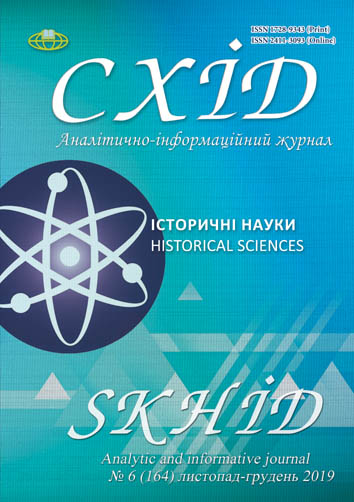Subcarpathian Ruthenia in conditions of pre-war international crisis of 1938 and territorial encroachments of neighboring states (on regional press materials)
DOI:
https://doi.org/10.21847/1728-9343.2019.6(164).186957Keywords:
Subcarpathian Rus, Carpathian Ukraine, Rusyns-Ukrainians, Czechoslovak crisis of 1938, Munich Agreement, press, “Ukrainian Piedmont”, common borderAbstract
Through the prism of the Subcarpathian press of the first third of the twentieth century, the tragic period of establishment of the Ukrainian statehood on the eve of World War II, the struggle for the free development of the Ukrainian nation on the territory of Subcarpathian Ruthenia due to the Munich Agreement and the dangerous political game of England, France, Germany and Italy, as well as Poland and Hungary, in the epicenter of ambitions of which Transcarpathia was caught, is delineated. Further development was given to the issues of struggle of the Ukrainians in Transcarpathia for the realization of the “peoples’ right to self-determination” in the course of the forceful formation of the joint Polish-Hungarian border after the Second Czechoslovak crisis of 1938, which had given rise to the actual division of Czechoslovakia on the one hand, and the intensification of Ukrainians’ national aspirations - on the other. The geopolitical aspects of the game of the Central Powers, as well as of Poland and Hungary in the process of “redrawing Europe”, the international peculiarities of the policy of appeasement of an aggressor of 1938 as a process of concessions and losses, in which the Transcarpathian lands remained as currency and the government of the autonomous Subcarpathian Ruthenia had to struggle alone against imperial revisionism, aggressive propaganda and destructive armed sabotage, were analyzed. Based on the Transcarpathian periodicals, the development of relations between the Carpathian Ukraine and practically the only foreign-policy partner - Germany - is shown in the context of the formation of the Hitler’s strategy of the “Eurasian Axis”, where the Ukrainian lands had a significant role. Factors of influence on the formation of the new European political reality and the role of the Ukrainian country in it are investigated. When using the press as a key source of historical data, a comprehensive picture of the Central Powers’ encroachments and aspirations and their practical intentions in an international crisis is reflected.References
Brashchaiko, Yu. (2009). «Shcho ya vydiv na Zakarpatti…» [«What I saw in Transcarpathia…»]. Uzhhorod: Lyra (In Ukrainian).
Vegesh, M. (2018). Derzhavno-pravovi osnovy isnuvannia Karpato-Ukrainskoi derzhavy (1938-1939). Naukovyi visnyk Uzhhorodskogo nazionalnogo universytetu. Seria: Mizhnarodni vidnosyny. Issue.3. (In Ukrainian).
Vengriia i Vtoraia Mirovaia voina: sekretnye diplomaticheskie dokumenty istorii kanuna I perioda voiny. (1962). Moskva: Politizdat. (In Russian).
Voloshyn, A. (1995). Tvory. Uzhhorod: Grazhda. (In Ukrainian).
Hyria, V. (2012). Ugorska iredenta v mizhvoiennomu Zakarpatti (“ugorskyi factor” u suspilno-politychnomu zhytti). Uzhhorod: Vydavnytstvo “Karpaty”. (In Ukrainian).
Homeniuk, I. (2017). Provisnyky Druhoi svitovoi. Prykordonni konflikty v Tsentralno-Skhidnii Yevropi. Vid rozpadu imperii do Hliaivitskoi provokatsii. [Proponents of the Second World. Border conflicts in Central and Eastern Europe. From the collapse of the empires to the Gleyevitz provocation]. Khakriv: CSD (In Ukrainian).
Grenzha-Donskіі, V. (1987). Shchastia I gore Karpatskoi Ukrainy: Shchodennyk. Tvory. Т. VІІІ. Washington: Vydannia Karpatskogo Soiuzu. Uzhhorod: Zakarpattia. (In Ukrainian).
Grenzha-Donskіі, V. (2003). Ia tezh ukrainets. (In Ukrainian).
Kosyk, V. (1993). Ukraina i Nimechchyna u Drugiĭ svitoviĭ viĭni. Paris; New-York; Lviv: Naykove tovarystvo imeni T. Shevchenka u Lvovi; Ukrainoznavcha biblioteka NTSh. (In Ukrainian)
Polski dyversiĭni dii v Zakarpatskii Rusi v svitli dokumentiv viddilu II Genshtabu Viiska Polskogo. (1998). Warshawa. (In Ukrainian).
Ternystyi shliakh do Ukrainy: Zbirnyk arkhivnykh dokumentiv i materialiv. Zakarpattia v yevropeiskii politytsi. 1918 - 1919, 1938 - 1939, 1944 - 1946 rr. XX st. (2007) [The Stinging Way to Ukraine: A Collection of Archival Documents and Materials. Transcarpathia in European politics. 1918 - 1919, 1938 - 1939, 1944 - 1946. XX century]. Uzhhorod: VAT «Vydavnyztvo Zakarpattya» (In Ukrainian).
Trofymovych, V., Trofymovych, L. (2018). Pytannia Pidkarpatskoi Rusi u zovnishniopolitychnykh rozrachunkach Polshchi (zhovten 1938 - berezen 1939 r.). Rusin. № 52. DOI: https://doi.org/10.17223/18572685/52/21 (In Ukrainian).
Coulondre, R. (1939). French Ambassador in Berlin, to M. Georges Bonnet, Minister for Foreign Affairs. Berlin, December 15, 1938. The French Yellow Book. Paris (In English).
Teroarea horthysto-fascista in nord-vestul Transilvaniei (1940-1944) (1985). Bucuresti (In Rumanian). Retrieved from: https://www.slideshare.net/FrescatiStory/teroarea-horthystofascista-in-nordvestul-transilvaniei-1940-1944
Downloads
Published
How to Cite
Issue
Section
License
Copyright (c) 2019 Tetiana Kuprii, Lidiia Tymish, Leonid Panasiuk

This work is licensed under a Creative Commons Attribution-NonCommercial-NoDerivatives 4.0 International License.
1. Authors bear responsibility for the accuracy of facts, quotations, numbers and names used.
2. Manuscripts are not sent back.
3. The publisher does not always agree with the authors' opinion.
4. The authors reserve the right to authorship of the work and pass the first publication right of this work to the journal under the terms of a Creative Commons Attribution Non-Commercial License, which allows others to freely distribute the published research with the obligatory reference to the authors of the original work and the first publication of the work in this journal.
5. The authors have the right to conclude separate supplement agreements that relate to non-exclusive work distribution in the form in which it has been published by the journal (for example, to upload the work to the online storage of the journal or publish it as part of a monograph), provided that the reference to the first publication of the work in this journal is included.

